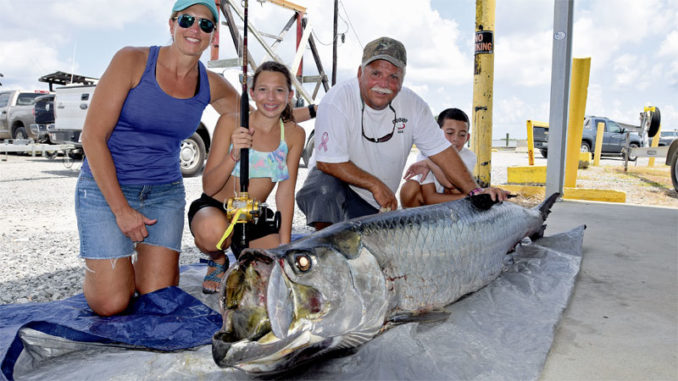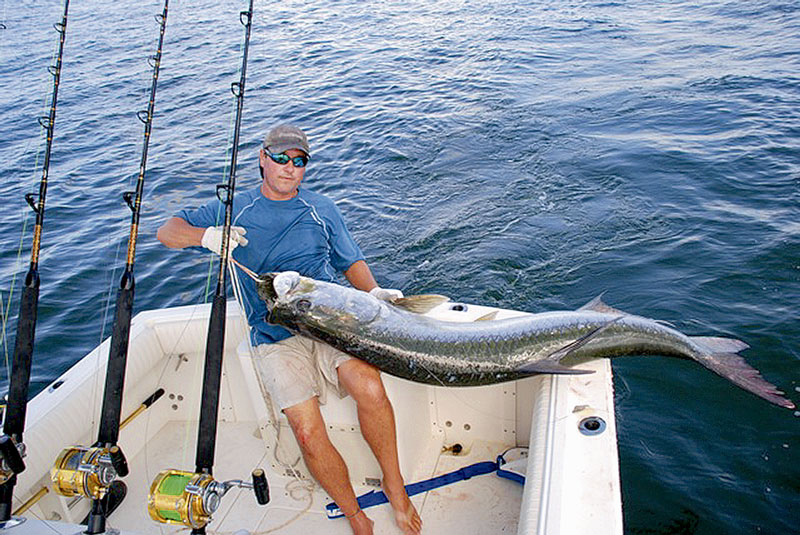
The acrobatic silver king makes anglers happy up and down the Gulf and south Atlantic coasts
Tarpon, Megalops atlanticus, is a highly-prized gamefish for recreational anglers throughout its range. A combination of reasons contributes to tarpon’s status among anglers.
These fish are highly acrobatic, usually jumping numerous times once they are hooked. During these fights, they attempt to throw the hook, which more often than not, they do. A battle with a tarpon — even a losing one — often sticks in an angler’s mind as one of their greatest angling feats.
Most anglers have far fewer chances at tarpon than other fish. Other than along the coast of Florida, tarpon do not spend the entire year in range of most anglers. Along the Mississippi and Louisiana coasts, they usually appear in late spring or early summer, and most leave near the end of summer. Smaller numbers stick around through the end of September, and even fewer remain into late October.
Another reason for anglers’ fondness of these fish is that they grow to enormous sizes. Every single tarpon in Louisiana’s Top-10 list weighed at least 220 pounds. The Louisiana state record tarpon weighed 246.63 pounds. David Prevost caught the fish in the West Delta Block in October 2015. The Mississippi state record, caught by Don Ruiz on Aug. 2, 2019, weighed 185 pounds, 8.80 ounces. The world record tarpon tipped the scales at 286 pounds, 9 ounces. Max Domecq caught the fish in March 2003 out of Rubane, Guinea-Bissau.
No close relatives
Belonging to the family Megalopidae, tarpon are the only member of this family to occur regularly along the eastern and southern U.S. coastlines. They are silvery in appearance, looking very much like super-sized herring with very large scales and a long body. When young, they are often confused with eels.
Tarpon have flat sides; sides and belly are silvery. Their backs are often dark blue to greenish-black, but this color changes depending on the waters they visit or in which the reside. The dorsal fin’s last ray is greatly elongated.
Female tarpon reach sexual maturity at about 70 inches long, usually in their 10th year. Males reach sexual maturity at about 50 inches long. Females in the wild can live as long as 55 years. Males normally don’t live longer than 43 years.
Tarpon mostly travel in small schools of 10 to 12 fish. They sometimes gang up in large schools of more than 100, especially when making long runs as seasons change.

Apex predators
These fish are apex predators. They eat pretty much whatever they want, and their presence — even for short periods of time — means the water quality and presence of other fish is excellent. They are unusually tolerant of freshwater.
Most tarpon that are caught along the eastern seaboard and Gulf of Mexico come from Florida, where the spend their winters. They travel in good numbers up to the North Carolina/Virginia state line, with smaller numbers of fish traveling farther north, even as far as Nova Scotia. Others move along the Gulf Coast states, to Texas and farther south.
The tarpon fishery in Louisiana has a long history, with Lake Charles forming its own tarpon club in the 1930s. The oldest fishing tournament in the United States is the International Grand Isle Tarpon Rodeo, which has been held yearly since 1928.
Anglers catch tarpon on numerous lures and with numerous strategies. Sight-fishing is popular, and when an angler spots one, he usually casts topwater lures or big jigs with long streamers. Fly anglers catch their share with giant flies. Live croakers or other small fish are also great baits.